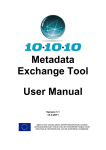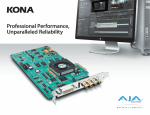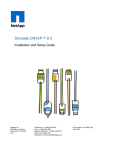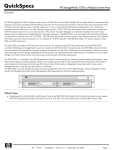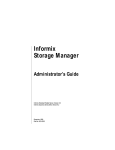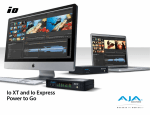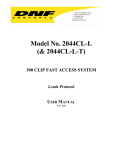Download Medway Configuration & Sales Guide
Transcript
Sept 2011 Medway Configuration Configuration Sales Guide & Sales&Guide Marquis Broadcast Ltd Software Release 2.6 Marquis Broadcast Limited www.marquisbroadcast.com Contents 1. 2. Management Overview .......................................................................... 3 An Introduction to Medway .................................................................... 4 2.1 Optimising Broadcast Workflows Performance..................................... 4 3. Medway The Media Highway .................................................................. 5 4. Media Workflow Examples ..................................................................... 7 4.1 Importing to Edit Storage using Medway ............................................ 7 4.2 Exporting to Video Server using Medway............................................ 8 4.3 Integration with Avid Interplay ......................................................... 9 4.4 Medway Bridging - FCP and Avid Sequence Transfer .......................... 10 4.5 Medway Parking – Edit Sequence Archiving ...................................... 11 5. Medway Architecture........................................................................... 13 6. Medway Solutions ............................................................................... 14 6.1 Medway Standalone Avid NLE Solution - MMW-STL ........................... 14 Medway Edit Solution - MMW-EDT ........................................................... 15 6.2 Medway Transmission Solution MMW-TXM ...................................... 16 7. “Pick and Mix” Configurations ............................................................... 17 7.1 Medway Standard Connection Licences ............................................ 17 7.2 Medway Additional Connection Licences ........................................... 18 7.3 Medway Additional Functionality ..................................................... 20 8. Sample Configurations ........................................................................ 22 8.1 Medway Bridging – Integrating Avid & FCP ....................................... 22 8.2 Medway Parking – Archiving Edit Sequences..................................... 23 9. Minimum PC Specifications .................................................................. 24 9.1 Network Architecture ..................................................................... 25 10. Supported Platforms & Devices .......................................................... 26 11. Supported Standards & Formats ........................................................ 27 Document History Version Date Description Authors V2.8 V2.9 V3.0 V4.0 April 2010 Sept 2010 Feb 2011 Sept 2011 Formats Updated Updated for 2.5.4 Release Update to supported devices Updated for 2.6 Release SF SF SF SF © Copyright Marquis Broadcast Ltd Page 2 Sept 2011 1. Management Overview Marquis was established in 1998, borne out of a commitment to providing user-friendly interoperability between best of breed products, within dataintensive environments. Marquis provides a range of specialist bespoke services for the introduction, implementation and operation of new technology. The company’s teams of consultants and software developers possess an in-depth knowledge and many years of experience in a variety of disciplines gained in both the broadcast and software industries. Over the last ten years Marquis has built strong relationships with most of the major suppliers to the broadcast industry. Numbered amongst these are Avid Technology Inc., Dalet, Harmonic and Harris with whom we are development partner as well as a range of other broadcast manufacturers (see Section 10). Marquis has considerable experience in integrating an extensive range of broadcast platforms and devices providing seamless integration and workflow via its simple and easy to use Media Highway Technology. Medway The Media Highway is in use on a daily basis with broadcasters in Asia, Europe and the Americas. Marquis have supplied solutions to many major broadcasters including Turner Broadcasting, BBC, BSkyB, YLE, Deutsche Welle, Bayerischer Rundfunk and Network Ten. Sept 2011 Page 3 2. An Introduction to Medway 2.1 Optimising Broadcast Workflows Performance Complex digital workflows are hampered by expensive and repetitive operations brought on by file incompatibilities. Medway from Marquis Broadcast provides a transparent and cost-efficient route to removing these bottlenecks. Medway transfers both Media (Essence) and descriptive data (Metadata) enabling the whole production process to be maintained in a digital environment. Media is re-wrapped and streamed during its movement and therefore provides faster than real time transfer of content. The need to produce interim files or go out to tape is totally removed thus minimising errors and significantly improving output quality. Furthermore, by allowing ‘Metadata’ to be moved with its associated media, Medway enhances tracking so that media can never be lost, thus maximising the return on your very expensively produced assets. Medway uses a simple and intuitive drag and drop interface which allows for the exchange of media between a wide range of ‘Best of Breed’ broadcast platforms in a transparent and user friendly way. Medway is compatible with a host of editing systems, video servers, storage, archive and asset management systems, browse, automation systems and removable media devices as well as a rich gamut of broadcast media formats, thus ensuring maximum benefits are derived from the whole acquisition to playout process. The benefits that can be gained from the use of Medway can be summarised as follows: Page 4 Interoperability between a wide range of ‘Best of Breed’ professional platforms Improved performance and efficiency of broadcast workflows Both financial and time savings through reduction in manual operations Enhanced production quality More effective management of your assets Sept 2011 3. Medway The Media Highway Medway is a sophisticated software tool kit delivering a seamless and costeffective integration between leading broadcast content applications. From a single user-friendly interface it enables media files, from multiple sources, to be transferred quickly between a wide variety of vendor platforms. Designed specifically to meet the demands of the most challenging of environments, Medway is suitable for all digital applications, including newsrooms, playout centres, production and post production suites, as well as front and back office processes. Medway eliminates file incompatibility issues that occur when media and its associated metadata is moved between target platforms, by providing quick and transparent format conversion of both the file wrapper, and the file essence, as necessary. Medway uses an intuitive drag and drop interface that allows the user to move media between a range of broadcast servers and editing systems. The lists of clips on the servers can be browsed from any Medway client and the selected clips can be dragged into the NLE bin for editing. An additional feature allows browse system EDLs to be imported directly onto the editor’s timeline, along with all associated media files. The finished edited sequence can then be dragged from the bin to a desktop icon for automated transfer to the transmission server. All transfers are carried out seamlessly as background tasks leaving the production staff free to concentrate on the creative aspect of content production. Sept 2011 Page 5 The primary focus for Medway is the integration of broadcast and production workflows at the fastest available network speed. This allows all transfers to happen faster than real-time. Another way to understand Medway’s capabilities is to think of it as all of the plumbing and connectivity that brings together a number of similar, but isolated, islands or platforms. It is the “Interoperability engine” that enables a complete digital workflow. Ensuring best of breed products such as edit platforms, either standalone or using shared storage, such as Unity, ISIS, Lanshare, Interplay or XSAN and third-party servers such as Omneon and Harris can work seamlessly together (See the full list in Section 9). However, Medway offers much more power and flexibility and can be connected to Media Asset Management systems. It can source reference edits from Browse systems, integrate with Archive Management systems and can supply file registration to, or be directly controlled by, Automation systems. All these features can be customised to suit the requirements for specific workflow or business solutions. With the move to complete file based production workflows, metadata is key to ensuring that you never lose your media. If you do not know what you have got, where it is and if you have the right to us it, then it is of no value to you whatsoever. To this end Medway has been designed with extensive metadata capture, editing and handling capabilities, covering basic, advanced or customised implementations, to ensure that metadata is created and utilised at every stage of the creative production process. Page 6 Sept 2011 4. Media Workflow Examples 4.1 Importing to Edit Storage using Medway Medway allows the video Editor to browse and retrieve material from a video server to the editing storage. Providing an intuitive interface, it becomes a simple drag and drop process to locate the required clip and initiate a transfer to the desired destination. The video server can either be searched as whole, or Medway can link to Media Asset Management systems and the results of any searches shown in the explorer window. Browse EDLs from shot logging/proxy editing systems can also be dragged, triggering Medway to retrieve the referenced media from the source video server and transfer it to the desired destination server. Medway takes care of the file formatting to suit the desired destination servers. The Medway Client (Windows) The Medway Client (Mac) Sept 2011 Page 7 4.2 Exporting to Video Server using Medway The interface to Medway was designed with workflow in mind. In today’s digital workflow it’s easy for media to become lost and float about a system. Exporting to directories is fraught with potential problems. Marquis have solved this on Windows based editors by using a unique concept called ‘The Drain’. Avid editing platform showing ‘The Drain’ Icon which is mapped to a video server (labelled VDR) For example to export from an Avid editing platform to a Video Server, (Labelled VDR in the above diagram), the sequence is dragged from the edit bin onto ‘The Drain’. Medway will then take care of the flattening of the video and building the completed edit on the designated server in the correct format for playback. Medway is designed to be very flexible in terms of its metadata handling capability. Basic or custom metadata can be created or carried with the clip and sent to a Media Asset Management system, either as a transparent process or by invoking a dialog box when the editor drags the sequence onto ‘The Drain’, allowing relevant metadata to be entered. For the Mac based Medway Client, as floating Icons are not possible within the Mac environment, the Export of sequences is controlled by the use of automatically configured menu options for FCP and via the “Send To” function within Avid. The destination locations are set by the Medway configuration and will automatically appear within the FCP export menus. Editors can select a sequence and then chose the required destination location from the menu. The Medway server will then progress the transfer. Page 8 Sept 2011 4.3 Integration with Avid Interplay The Medway InterPlay web services integration allows Medway to read and write to and from an InterPlay equipped Avid workgroup without the need for a Medway client running on the Avid workstations. Clips or Sequences transferred into the Avid workgroup are registered with the InterPlay database, and placed in a pre-configured folder in the InterPlay tree structure. As soon as Medway starts writing media to the ISIS storage the corresponding clips is added to the InterPlay database in the corresponding InterPlay Folder. The user may drag the clip from InterPlay into their bin to use it during or after transfer has completed. The clip may also be opened directly from InterPlay using Assist or similar Avid tools. For export, Medway can be configured to monitor a separate folder in the InterPlay Tree structure and transfer any Clips or Sequences found there to the selected Medway destination. When Clips or Sequences are dropped into the corresponding folder Medway will pick them up, resolve the clip or sequence and transfer it to the corresponding destination. Different folders may be configured with different destinations, allowing the user to chose where to send a clip based on which folder it is dropped in ( “To Transmission”, “To News”, “To Archive” ). Alternatively if ‘auto transfer’ is turned off in Medway the contents of the folder may be browsed using the Medway user interface, and a transfer initiated to the required destination by dragging and dropping within the Medway User Interface. This same behaviour can also be controlled via the API. The benefits that can be gained from the use of Medway can be summarised as : Sept 2011 Seamless integration between Avid InterPlay systems and any other devices that Medway can be connected to Requires no third party application running on the Avid workstations Allows media transferred into the Avid workgroup to be managed from within Interplay Support for ‘Edit while Transfer’ Transfer Status updates appear in Interplay Page 9 4.4 Medway Bridging - FCP and Avid Sequence Transfer Many production facilities have a mix of Avid and Apple Final Cut Pro editors. It will often be desirable for work to be moved between the two systems. Medway now provides a very convenient and easy to use method to transfer a sequence from one editor to the other, ensuring that all of the media and timeline structure are moved seamlessly between the two. The benefits that can be gained from the use of the ‘FCP <> Avid Sequence Transfer’ functionality within Medway can be summarised as: More freedom in planning and organising productions Better collaboration between staff using different technology Easier to use best of breed tools for different stages of the production Saves time and effort when transferring edits between editors. Based on the shots that appear in the sequence timeline Medway will perform partial transfers of source material from the source editor and transfer that material to the destination editor, converting the media on the fly between the different formats, MXF Atoms for the Avid and QuickTime wrapped media for the Apple. Only material referenced in the sequence, plus configurable handles, will be transferred. Medway will then convert the Sequence details from the format of the source editor to the format of the destination editor (AAF to FCP XML or vice versa), updating any references to the media along the way to point to the newly created clips. Only the timeline structure and the media will be moved, effects and transitions will not be converted. Any transitions will be replaced with dissolves. If the codec is unsupported on the destination (e.g. DNxHD) the transcoding Medway option will be needed to transcode to a codec which is supported on the target device. The Medway Bridging function is included as a configurable option within the standard product offering for solutions with Avid and FCP systems. Page 10 Sept 2011 4.5 Medway Parking – Edit Sequence Archiving It is often necessary for a video editor to want to resume work on an edit some time after the original work. It is therefore important to be able to take a ‘job’ ‘off-line’ when it is no longer needed and to be able to restore it when it is needed again. The Medway user interface allows the editor to ‘Park’ the edit in an “archive”. Medway will create an ‘Edit Sequence Archive’ file, it will then examine the edit and copy all of the video and audio material referenced in the edit into the archive file. Medway will also copy the sequence data containing, not only all of the timeline structure data, such as which bits of the material are used where and on what track, but also all of the transition, effects and audio level data which may have been set during the editing process. An important quality of the Marquis ‘Parking’ feature is that the archive files are open, and based on industry standards and readable by any application. This helps to ensure that they remain useable for a long time into the future and are not dependant on a particular manufacturer or software version. If required, Avid based systems have the option to leave the content in the original MXF Op atom format. The benefits that can be gained from the use of the ‘Parking’ functionality within Medway can be summarised as: Open standard archiving of edit jobs Save on usage of precious editing storage Archive restores may be initiated from any workstation equipped with a Medway Client Archive files may be transported and restored into different systems Complex sequences are archived into a single file, this makes managing the archive easier and copying on and off data tape more efficient. Archive created on Avid may be restored to FCP and vice-versa A configuration on the Medway server will allow the system manager to add additional handles to the material sent to the archive allowing the editor to have some additional material to trim his edit after it has been restored. Medway Parking now supports three different options to allow the systems to choose how the media exports will be handled. These are:- Sept 2011 Page 11 4.5.1 Sequence Archive The standard sequence archive method will take just the media referenced on the sequence, plus any configured handles, and convert the content into the standard format (MXF OP1a for Avid, QT for FCP). This method limits the size of the Parking Archive file and is especially useful when archives are being used as distribution elements. This is chosen by ensuring that "Complete Source" is not selected on the summary screen of the configuration tool. 4.5.2 Complete Source Archives The Complete Source option will allow Parking to move the whole source file when it is referenced within a sequence. Any media referenced within the sequence timeline will have the entire source clip moved into the Parking Archive file. The content is converted into the standard format (MXF OP1a for Avid, QT for FCP). This method will increase the size of the Parking Archive file but will allow greater flexibility when re-working sequences. Ticking the "Complete Source" option in the summary screen will select this option. Once "Complete Source" is chosen handles are no longer available as an option. 4.5.3 Full Copy Parking Full Copy Parking will move the whole source files of media referenced in the sequence into the Parking Archive, in their original format. Therefore, for Avid systems, Parking will copy the original MXF Op Atom files into the Parking Archive. This is set by choosing the "Full Copy" export option within the Parking Client Application. The Medway Parking function is included as a configurable option within the standard product offering and will only require a connection to the “Archive” location to be added to the solution. Page 12 Sept 2011 5. Medway Architecture Medway has been designed to be a scalable solution that can be expanded to meet your needs. With a modular architecture and flexible licensing system, the Medway user can easily add more broadcast servers, or Medway clients as required. In addition, the system can be interfaced with Automation and Asset Management Systems and EDL’s can be imported from a variety of editing systems. As well as natively supporting a number of different SD CODECS, Medway also offers native HD support, as part of its standard feature set, thereby ensuring complete SD to HD migration. In addition this level of flexibility can be enhanced by adding SD to SD or HD to HD Transcoding. Medway consists of three basic “notional” functional components:Medway Client – The GUI for browsing, initiating and monitoring transfers Medway Control Server – The control and database manager Medway Transfer Engine – The data handler for transferring media between different devices Designed to be part of the broadcast workflow, Medway can operate either standalone or be integrated with Media Asset Management systems, Browse systems, Archive, Automation systems and removable media. A list of current supported platforms and devices is available in section 9. Sept 2011 Page 13 6. Medway Solutions The following pages show a number of pre-configured Medway Solutions that enable customers to purchase simple pre-defined configurations. In addition Medway can be specified from a number of “pick and mix” components to build a more detailed or complex system. These “pick and mix” items can also be added to the pre-configured solutions, 6.2 and 6.3, for added flexibility. Further details of each of the Medway components are explained in Section 7. If none of the configurations shown here cover the requirements for your system, please consult with Marquis Broadcast or your local dealer to discuss a configuration that will cover your requirements. 6.1 Medway Standalone Avid NLE Solution - MMW-STL Single Avid Edit Workstation, Single Video Server. This shows a single Avid Edit workstation that is connected directly to a video server and is suitable for standalone Avid workstations with local storage only. This configuration allows the editor to send sequences to the video server as well as browse and retrieve material already stored there. This includes a Medway control server, Transfer Engine and Medway client GUI, all running on the Avid workstation. NOTE: PC only, Medway does not support Avid on MAC OS. Medway Standalone Avid NLE Solution Consists of: Page 14 1 x MWW-STL Standalone AVID Solution Sept 2011 Medway Edit Solution - MMW-EDT Up to 20 Edit Workstations with connection to single Edit Shared Storage and a single Video Server. The Medway Edit Solution allows for 1-20 editing workstations connected to single Edit Shared Storage and a single Media Server. A Medway client GUI on each edit workstation provides the ability to move material between the Edit Shared Storage and the Video Server. Each Medway client GUI displays all Medway initiated transfers and their progress and status for the total system. This includes one combined Medway Control Server and Transfer Engine. Medway Edit Solution Consists of:- Sept 2011 1 x MMW-ESS Edit Shared Storage Connection Licence 1 x MMW-SRV Media Server Connection Licence Page 15 6.2 Medway Transmission Solution MMW-TXM Up to 20 Edit Workstations connected to Edit Shared Storage and two Video Servers. This includes Integration to a Media Asset Management system with Browse EDL capability and an Automation System. For a more complex system, the Medway Transmission Solution builds on the Edit Solution with additional connection Licences to Media Asset Management with Browse EDL for sequencing and sourcing from shot lists or EDLs. Configurable metadata criteria can be read from and written to the MAM system allowing metadata sourcing from EDLs and databases. Similarly, metadata captured at the edit workstation can be passed to external systems. External Automation is shown providing API driven control and display information of Medway transfers. This includes a main control server and a Redundant Control Server as well as one Transfer Engine (within the control server). Medway Transmission Solution Consists of:- Page 16 1 x MMW-ESS Edit Shared Storage Connection Licence 2 x MMW-SRV Media Server Connection Licence 1 x MMW-RED Redundant Controller 1 x MMW-AUT Automation System Connection Licence 1 x MMW-MAM Media Asset Management Connection Licence Sept 2011 7. “Pick and Mix” Configurations The following section provides details of all of the individually configurable Medway components. These individual components can be used “Pick and Mix” style in combination on their own, or they can be added to the Medway Solutions, 6.2 and 6.3, that have already been described. The pick and Mix section is dived into three areas:1. Medway Standard Connection Licenses 2. Medway Additional Connection Licenses 3. Medway Additional Functionality 7.1 Medway Standard Connection Licences 7.1.1 MMW-ESS - Edit Shared Storage Connection Licence This licensing option provides connection to edit shared storage such as Avid Unity, ISIS, LANShare, Interplay or Apple XSan. Workstations editing sequences directly on this storage will be able to use Medway Client GUIs to move files in and out of their workspaces. One ESS connection per licence with 1-20 edit clients. Therefore if you require additional Edit Shared Storage connections or an additional (20 at a time) edit clients then additional MMW-ESS Edit Shared Storage Connection Licences will be required. This option also provides connection and functionality with Interplay. Example platforms: ISIS, Unity, Lanshare, Apple XSAN 7.1.2 MMW-LES – Local Edit Storage Connection Licence This licensing option provides for a single connection to Avid or Apple FCP workstation, with Local Storage, to move files in and out of their workspaces. One connection per licence Additional MMW-LES Licences can be used in parallel according to the number of workstations with Local Storage. They can also be used in conjunction with MMW-ESS Edit Shared Storage Connection Licences. Example platforms: Avid or FCP with local storage Sept 2011 Page 17 7.1.3 MMW-SRV – Media Server Connection Licence This licensing option provides connection to storage on a video or file server. One licence is required for each video server connection. It is possible to configure a number of separate volumes or clip directories for each connection license, but connection to the same storage via a separate host will require a separate licence. Example platforms: Omneon, Harris, GVG, EVS, 360 Systems, Generic File Servers This licence will also be used with the Medway Parking functionality. The easiest way to configure a system is to start by choosing either: Medway with Local Edit Storage and Video Server Connection Licences Medway with Edit Shared Storage and Video Server Connection Licences This will give a standard working configuration with separate Medway Server and Medway Clients. Includes one control server and one Transfer Engine. 7.2 Medway Additional Connection Licences 7.2.1 MMW-ARC – Archive System Connection Licence This licensing option provides connection to an Archive Management system and enables edits and partial transfer requests to be sent to and retrieved from off-line storage. One connection per licence. Example platforms: Front Porch Digital DIVArchive 7.2.2 MMW-AUT – Automation System Connection Licence This licensing option provides connection to an automation system. Medway’s API, allows control and display functionality, available to the Medway Client GUI, to be controlled and monitored by third-party automation systems. Allows multiple connections. Full API documentation and an example SDK is available on request. Example platforms: Harris, SGT, Omnibus Page 18 Sept 2011 7.2.3 MMW-MAM - Media Asset Management Connection Licence This licensing option provides connection to Media Asset Management systems and can provide many forms of metadata capture, exchange and storage as well as Browse EDL capability Medway can query an external MAM system based on configurable metadata criteria and show the search results in the Medway Client GUI. Medway is aware of the metadata in the editing application and can, along with custom metadata added at the time the clip is exported, push this information to the MAM. Medway can export an XML file containing basic and user-defined metadata from the NLE edit sequence and / or captured / entered at the export stage, to a user-defined network folder Please consult with Marquis for details on customisation and adapting to individual metadata schemas and workflows. The MAM option also gives access to genealogy reporting that will identify the parentage or history of a sequence, including video tracks, slo-mo or off-speed sequences, audio tracks, FX processing as well as other XML Metadata. This licensing option provides connection to a file server holding EDL references to online high resolution media. Medway will import a sequence file (EDL) created by a browse editing system, identify the media required in the edit, find the media on a high resolution server, move the required media to the NLE, and then build a new sequence file compatible with the NLE that can be imported directly to the NLE. This new sequence will therefore already be linked to the media which has just been moved and is ready for further craft-editing. This process avoids the need for lengthy manual ingesting and linking of media files. Please refer to the separate document that describes Marquis’ generic XML EDL format. Includes multiple connections. Example platforms: Dalet, Harris Invenio, Omnibus, TMD, Artesia, S4M Sept 2011 Page 19 7.3 Medway Additional Functionality 7.3.1 MMW-SCG – Medway Simple Client GUI For a system comprising separate Medway server and clients, a Simple Client GUI will allow any PC or Apple (IE non editing platform) connected via the network to browse, initiate or monitor transfers between edit and video storage. This is particularly useful for non-editing users, such as Media or MCR Managers to preload material for editing and monitor file delivery between ingest, production and transmission storage areas. This allows standard Medway GUI control only and does not support “The Drain”. Please specify Windows or MAC OS X Tiger or Leopard operating system. 7.3.2 MMW-RED - Redundant Controller Provides 100% fail safe redundant architecture for the control and database server functionality, thereby providing automatic back up operation. Features include: Automatic changeover of Medway control server. Transfers in progress in any separate Transfer Engines will complete normally. Database of clips, configuration & current tasks as well as status are automatically mirrored between the main / backup control servers. No requirements for third party clustered servers. 7.3.3 MMW-ENG - Additional Transfer Engines One Transfer Engine is provided by default in a Medway configuration. If the system design includes multiple Edit Shared Storage arrays, then additional transfer engines are required one per Edit Shared Storage array, even if there is a single destination video server. If the system design throughput of data and transfer rate are coupled with requirements for multiple edit workstations, video servers or large volume of transfers, then additional Medway transfer engines can be deployed and configured to provide a bigger pipe and hence improve throughput efficiency. The Additional Transfer Engines allow for the configuration of transfer groups leading to manageable, system-wide load balancing. Page 20 Sept 2011 7.3.4 MMW-TRN - Transcoding Processor The Transcoding Processor is an option for the Transfer Engine and provides for SD to SD Transcoding or HD to HD Transcoding. Requirements for Transcoding processors will be 1:1 for each additional Transfer Engine, plus 1 for the basic system. SD CODECS supported for Transcoding are:DV-25, DVCPro-25, DVCPro-50, MPEG-2 IMX 30/40/50, MPEG-2 I frame – 20MB/s to 50 MB/s, MPEG-2 Long GOP – 5MB/s to 50MB/s, YUV 8-bit, YUV 10-bit. HD CODECS supported for Transcoding include:DNxHD, DVC Pro HD, ProRes, AVC Intra, XD CAM HD, MPEG-2 LGOP (20200)& MPEG-2 I-Frame (50-200) e.g. DNxHD 720P 8-bit 120 @ 50Hz & 145 @ 59.94Hz DNxHD 720P 8-bit 185 @ 50Hz & 220 @ 59.94Hz DNxHD 720P 10-bit 185 @ 50Hz & 220 @ 59.94Hz MPEG-2 Long GOP – 20MB/s to 200MB/s DNxHD 1080i 8-bit 120 @ 25Hz & 145 @ 29.97 MPEG-2 I Frame – 50MB/s to 200MB/s DNxHD 1080i 8-bit 185 @ 25Hz & 220 @ 29.97 DNxHD 1080i 10-bit 185 @ 25Hz & 220 @ 29.97 Important Notes: Sept 2011 Transcoding is Bi-directional. Medway does not support frame size or frame rate conversion. The list of supported CODECS for Transcoding is different from native CODEC support; please see section 10, for a full list of native CODECS supported. For the purposes of licensing, a Medway installation is counted as one connection to one main (or one main and one redundant) Medway Control Server. A Medway installation offers SD and HD native support as standard. i.e. there is no additional charge for upgrading to HD native support. Page 21 8. Sample Configurations Below are some sample configurations that can be used within a Medway system 8.1 Medway Bridging – Integrating Avid & FCP The integration of Avid and Final Cut Pro editing systems can be configured to allow for Edit Sequences to be transferred between the two environments. This is a configurable function within the standard product offering. Two of the possible system configurations are shown below. 8.1.1 Mixed Shared & Local Edit Storage One Edit Shared Storage System and Multiple Local Edit Storage machines The system above shows one Edit Shared Storage system being connected to the other edit system which is running with multiple Editors that are using locally stored material. This example would require the following line items:- Page 22 1 x MMW-ESS Edit Shared Storage Connection Licence 3 x MMW-LES Local Edit Storage Connection Licence Sept 2011 8.1.2 Multiple Edit Shared Storage Systems Two Edit Shared Storage Systems The system above shows two edit shared storage systems being connected by the Medway system. All editing clients are working of the shared storage and there is no locally stored material. This solution would require the following line items: 2 x MMW-ESS Edit Shared Storage Connection Licence 8.2 Medway Parking – Archiving Edit Sequences The ability to “Park” Edit Sequences within a storage “Archive” is a configurable option within the Medway system. While there no additional cost for the Parking functionality, the configured system will require a licence to connect to the storage location. This is the standard Media Server Connection licence. Therefore to add the Medway Parking to any of the solutions shown within this document all that is required is the following: Sept 2011 1 x MMW-SRV – Media Server Connection Licence – Per archive location Page 23 9. Minimum PC Specifications NOTE: In a simple system, the Medway Controller and Medway Transfer Engine can reside on the same PC. System design may require additional Transfer Engines and Medway Transcoding processors. Higher specifications are required for Transfer Engines with Transcoding processing. NOTE: PC only, Medway does not run on MAC OS or MAC with Windows. Medway Control Server Hardware Specification PC Windows Workstation or Windows Server. Pentium4 3GHz or higher 1GB RAM or higher 10GB Hard Disk or higher 1Gb Ethernet NIC minimum Non-Transcoding Transfer Engine Hardware Specification PC Windows Workstation or Windows Server. Pentium4 3GHz or higher 1GB RAM or higher 10GB Hard Disk or higher 1Gb Ethernet NIC minimum (2 x NICs preferred) Standard Definition Specification Transcoding Transfer Engine Hardware PC Windows Workstation or Windows Server. Xeon 2 x Dual Core >= 2.6GHz 2GB RAM 10GB Hard Disk or higher 1Gb Ethernet NIC minimum (2 x NICs preferred) Page 24 Sept 2011 High Definition Transcoding Transfer Engine Hardware Specification PC Windows Workstation or Windows Server. Xeon 2 x Quad Core >=2.6GHz 4GB RAM 10GB Hard Disk or higher 1Gb Ethernet NIC minimum (2 x NICs preferred) Medway Server/Transfer Specification Engine Operating System Required Windows 2003 Server Windows 2008 Server R2 Windows XP Professional with Service Pack 2 Windows 7 - 64 Bit For Avid Unity connection, check the compatibility of the operating systems with the specific Unity. 9.1 Network Architecture A minimum of a Gigabit connectivity and backbone is required. Dual Network Interface cards are supported to enable separate connections in and out for transfers. Sept 2011 Page 25 10. Supported Platforms & Devices Medway supports transfers between a wide range of platforms and devices, as follows:Edit Platforms Apple Final Cut Pro Avid Media Composer Avid Symphony Avid Newscutter Edit Shared Storage Apple XSAN Avid Interplay Avid ISIS Avid Unity Asset Management, Automation & Browse Avid Interplay WS Dalet Enterprise Edition Harris Invenio iBrowse Ibis iFind IPV Curator Pharos Mediator TMD MediaFlex PebbleBeach Neptune/Marina Building4Media Video Servers Omneon - MediaGrid Omneon - Spectrum Omneon - MediaDeck EVS - XT2 Grass Valley Thomson - K2 Harris - Nexio 4000/3600/3601 SeaChange - BML Edit Share - Geevs Generic IT based storage: MXF, QuickTime and .AVI Archive & Storage Cache-A - Archive Appliance Front Porch Digital - DIVArchive Isilon - IQ Storage NetApp - StorageGrid Object Matrix - MatrixStore Quantum - StorNext SGL - Flashnet NOTE: Not all standards and formats are supported on all platforms and devices; please check with Marquis for confirmation of your required configuration. Page 26 Sept 2011 11. Supported Standards & Formats Medway supports transfers between a wide range of video standards and formats, as follows:Video Standards 625 & 525 1080i & 1080p & 720p – 24/25 – 23.976/29.97 – 24/25/50 – 23.976/29.97/59.94 Video Formats DV-25 (4:1:1 or 4:2:0) DVCPRO-25 DVCPRO-50 DVCPRO-HD IMX 30/40/50 MPEG-2 Long GOP MPEG-2 I-Frame DNxHD 120/145/180/220 ProRes 4:2:2, 4:2:2 (HQ), 4:2:2 (LT) XDCAM HD 35/50 AVC-Intra 50/100 YUV 8/10 Bit Editing Formats Avid OMF or MXF atoms Apple Quicktime Media Wrappers MOV (Quicktime Reference) MOV (Quicktime Wrapped) MXF - OP1a, OP1b, OpAtoms, AMWA Mastering Format AVI with Embedded Audio AVI with Separate WAV Audio GXF LXF (VR & NX4000) LXF (NX3600) DV (raw DV) NOTE: Not all standards and formats are supported on all platforms and devices; please check with Marquis for confirmation of your required configuration. Sept 2011 Page 27




























